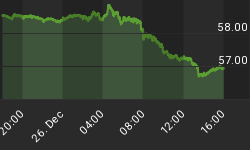Part one of this article compared the long-term predictions of two wave analysts: R. Prechter (a traditional Elliott Wave analyst) and G. Neely (who uses a form of Elliott Wave analysis he invented called NeoWave). In summary, Prechter thinks the DOW is going to under 400 sometime before 2015 and Neely thinks that it will not only stay above the 2002 lows but will go to 100000 by mid-century. Such predictions are extreme and get lots of attention but are useless to investors trying to make money in the here and now. Therefore, a short-term focus of Elliott Wave (as seen by Prechter) and NeoWave (as seen by Neely) is the subject of this short piece. By short-term, I am referring to the next two weeks of June.
In the past two weeks, Prechter has issued numerous warnings that the March highs are THE top of Primary Wave 2 and, therefore, the rally off the April low is a minor Wave 2 counter trend rally. This can be counted as a triple zig-zag that ended with Friday's upside gap in which the Dow retraced .667 of wave 1 down from the March highs and the S&P retraced more than .786 of wave 1 down. Sentiment figures support the notion that this interpretation may be correct given that the 5-day CBOE Volatility Index (VIX) is now under the level it achieved at the March 7 peak and the 5-day Daily Sentiment Index (DSI) is above its March 7 peak. Thus, bullishness is more extreme as of Friday June 17 than it was at the March highs, despite the fact that the Dow, S&P and NASDAQ are under their March highs. This is typical of wave 2 psychology. The same sentiment disparity occurred at the beginning of October 1987 when the DOW failed to reach the late August highs in a wave 2 counter trend rally. This set-up represents the shorting opportunity of a lifetime.
However, NeoWave theory sees an entirely different set-up. According to NeoWave theory, a psychological low can occur at a higher low in an index and it is from this point that one commences measurement of the wave structure. Thus, the low for the US indices occurred not in April but in the second weak of May. From that point one can clearly see a fantastic 5 wave impulse in all 3 indices, followed by a tight trading range (actually a triangle in the DOW and a rising wedge in the S&P) followed by an upside break-out and close on Friday. The first impulse would be labelled wave A, the trading range Wave B and Friday's breakout of the range the very start of Wave C. This analysis provides a very different opportunity: one for the Bulls, and it will crush any shorts who care to get in the way on Monday June 20, thus fuelling the rally with even greater excitement and SPEED. If this rally ensues, bullish sentiment figures are likely to WELL exceed all previous tops, including that of 1987 and 2000.
Where will the rally end? Well, if C is equal to A, a target of about 1250-1260 in the S&P 500 would be met, which is also the .618 retracement of the entire bear market rally. However, given the shallowness of the wave B trading range, wave C may end up being 1.618 times wave A. Under this potential, 1275-1280 will be seen. If EVERYBODY starts going short at 1253 because "it can't possibly go any higher", then the latter target is liable to play out as the short covering fuels a fast break through the trend line connecting the Winter 2004 highs with the March 2005 highs.
Who will win the wave debate in the short run? This is where traditional technical analysis can play a roll in determining the victor. Friday's GAP will tell the truth. If on Monday/Tuesday, Friday's gap in the S&P 500 is not filled and the index rockets above Friday's intraday high, the Bulls win. On the other hand, if the index fills the gap and can't get back over Friday's intraday high and then comes crashing under 1208 and then 1195 (exhaustion gap), the Bears are in for a treat and the Bulls must admit defeat, at least in the short run.
I favour the short-term bullish resolution because: 1) every day stocks in the S&P are breaking resistance and almost none are breaking support; 2) the great volume on the gap up Friday; 3) the S&P exceeded and closed above 1215 which was the last bastion of strong fibonacci resitance; and 4) there is a MASSIVE rising wedge pattern in all 3 indices that has yet to complete. That is, from the March 2003 low, there is an impulse than ends in Winter 2004, followed by a series of overlapping corrective waves into the August 2004 lows, followed by another strong impulse to Winter 2005, followed by a zig-zag correction from the March highs, followed by a half completed impulse back up as of Friday. Thus, converging trend lines with overlapping waves rising up. In Elliott Wave terms, it could be termed an ending diagonal. An extended C wave predicts a false break of the upper trend line on the final wave up but any sustained move above it would be very bullish and signal that an end to the rally probably will not occur until March 2006.
An ending pattern in the stock market coupled with the greatest credit bubble in economic history? You be the judge.
















